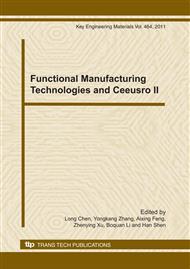p.609
p.614
p.619
p.623
p.627
p.632
p.637
p.642
p.647
Influence of Laser Shock Processing on the Weld Line and Finite Element Simulation
Abstract:
Welding residual stress is one of the main factors that affect the strength and life of components. In order to explore the effect on residual stress of welding line by laser shock processing, finite element analysis software ANSYS is used to simulate the welding process, to calculate the distribution of welding residual stress field. On this basis, then AYSYS/LS-DYNA is used to simulate the laser shock processing on welding line. Simulation results show that residual stress distributions of weld region, heat-affected region and matrix by laser shock processing are clearly improved, and the tensile stress of weld region effectively reduce or eliminate. The simulation results and experimental results are generally consistent, it offer reasons for parameter optimization of welding and laser shock processing by finite element analysis software.
Info:
Periodical:
Pages:
627-631
Citation:
Online since:
January 2011
Authors:
Price:
Сopyright:
© 2011 Trans Tech Publications Ltd. All Rights Reserved
Share:
Citation:


